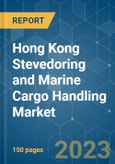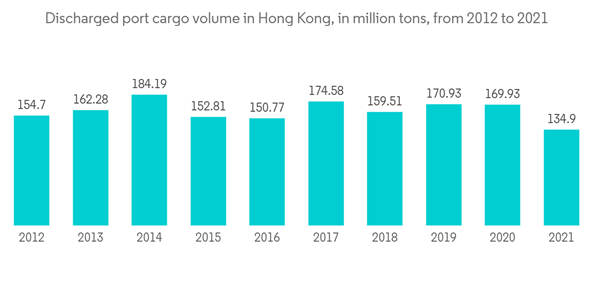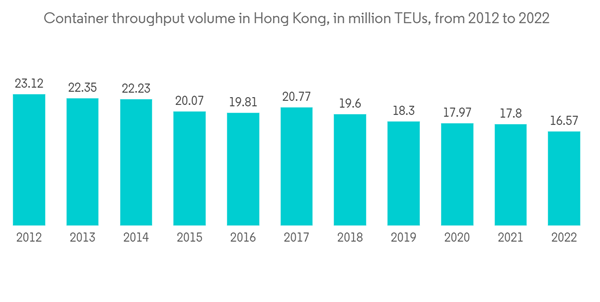The size of Hong Kong Stevedoring and Marine Cargo Handling market is USD 4.11 billion in the current year and is anticipated to register a CAGR of over 4% during the forecast period
As of the end of 2021, Hong Kong is the world’s fourth-largest shipping register following Panama, Liberia, and the Marshall Islands. Hong Kong Shipping Registry reported registered vessels totaling 128 million gross tonnes (GT) as of September 2022. Hong Kong’s port was ranked the ninth busiest container port in the world in 2021, trailing Shanghai, Singapore, Ningbo-Zhoushan, Shenzhen, Guangzhou, Qingdao, Busan and Tianjin.
The government's measures are assisting the maritime logistics companies. For instance, the Hong Kong government has double taxation agreements (DTAs) with numerous nations, including the United States, the United Kingdom, the Netherlands, Denmark, Norway, and Germany. Due to its low tax structure, solid institutional framework, and a cluster of maritime services, Hong Kong is regarded as the top option for foreign ship owners.
The development of smart ports has recently received strong support from mainland China. For instance, the Mawan Port in Shekou, Shenzhen, finished its renovation and transformation process in November of last year, incorporating blockchain, artificial intelligence, smart port, and green and low-carbon upgrades, making it the GBA's first 5G-enabled smart port. Another significant milestone was the completion of Phase IV of the automated terminal at Nansha Port, making it the first of its kind to operate in the GBA. Newer IoT sensors, 5G networking, and a variety of AI-enabled resources are a few of the terminal's enhanced features. The update has also made it possible to use fully automated container cranes and intelligently guided vehicles on-site.
Despite increasing competition in the area due to the development of ports and logistics infrastructure in mainland China over the past 10 years, Hong Kong's port continues to be one of the busiest container ports in the world. Hong Kong's port and its maritime sector face additional challenges as a result of the Pearl River Delta's (PRD) shifting manufacturing landscape, which is moving from labor-intensive manufacturing to high-tech industries as well as the trend of global manufacturers shifting and extending supply chains from the mainland to other countries.
Key Highlights
- Hong Kong's maritime cluster includes not only traditional maritime businesses like cargo handling and vessel operations but also maritime service industries like ship finance, brokerage, legal services, and marine insurance. The maritime industry is highly varied. According to official sources, the maritime and port industry contributed HKD 35.4 billion (USD 4.56 billion) to Hong Kong's gross domestic product (GDP) in 2020. This represented 1.4% of the overall output of the economy. The maritime sector supports the growth of the trading and logistics sector, one of Hong Kong's four pillar industries, in addition to its direct economic contribution.
- Hong Kong was the world's 6th largest trading economy in 2021. It was also an international maritime center characterized by a strong presence of ship owners, cargo owners, and traders in Hong Kong on the one hand and a vibrant maritime services cluster on the other. There has been a continual expansion in Hong Kong's maritime services cluster over the years, which offers comprehensive and professional services ranging from ship management, ship broking, stevedoring, marine cargo handling, and ship finance to maritime insurance and law.
- Hong Kong's ports appear to have fallen behind other Asian ports in recent years, as seen by the country's falling position in terms of the volume of containers handled internationally. It ceased to be the busiest container port in the world in 2005 and continued to fall in the worldwide rankings until it was ranked ninth during the COVID-19 pandemic.
- To further promote the development of Hong Kong as an international maritime center, the Transport and Logistics Bureau is going to set up a task force with the aim of putting forward, in collaboration with the Hong Kong Maritime and Port Board and representatives of the high-end maritime services industry. The Hong Kong Govt has allocated HK dollar 20m (USD 2.5m) in its 2023-24 budget to promote the high-end maritime service industry sector.
Hong Kong Stevedoring and Marine Cargo Handling Market Trends
Increasing Sea Freight Driving the Market
With one of the largest shipping populations in the world and a thriving maritime cluster that provides a full spectrum of high-quality maritime services, Hong Kong has made a name for itself as a prominent international maritime center. It benefits from a port infrastructure that is developed and well-located. Furthermore, it is a prominent center for global trade with lots of transportation involved in logistics. The ship registration system used by Hong Kong Shipping Register (HKSR) is distinct from that used by Mainland China. Hong Kong was the world’s 6th largest trading economy in 2021 with international trade immensely facilitated by its efficient port amid a strong presence of ship owners, cargo owners, and traders. Over the years, Hong Kong has seen a continual expansion of its maritime services cluster, comprising ship management, ship broking, ship finance, maritime insurance, and law.As of the end of 2021, Hong Kong is the world’s fourth-largest shipping register following Panama, Liberia, and the Marshall Islands. Hong Kong Shipping Registry reported registered vessels totaling 128 million gross tonnes (GT) as of September 2022. Hong Kong’s port was ranked the ninth busiest container port in the world in 2021, trailing Shanghai, Singapore, Ningbo-Zhoushan, Shenzhen, Guangzhou, Qingdao, Busan and Tianjin.
The government's measures are assisting the maritime logistics companies. For instance, the Hong Kong government has double taxation agreements (DTAs) with numerous nations, including the United States, the United Kingdom, the Netherlands, Denmark, Norway, and Germany. Due to its low tax structure, solid institutional framework, and a cluster of maritime services, Hong Kong is regarded as the top option for foreign ship owners.
Technological Advancements in the Maritime Transportation Sector
In order to address recurring management issues and boost productivity, the maritime industry is embracing new technologies. Remote-controlled rubber-tired gantry cranes (RTGCs) and an automated container stacking system were introduced by HIT, the first container terminal operator in Hong Kong. The 29 cranes at Kwai Tsing Port each have monitoring cameras and sensors installed to assure complete precision, improving operational safety and efficiency. The largest port in Europe, the Port of Rotterdam, is also testing innovative approaches to streamline operations by utilizing autonomous vehicles. In order to provide a smoother traffic flow, truck platooning, which involves a group of automated trucks traveling closely behind a lead vehicle, is now being tested.The development of smart ports has recently received strong support from mainland China. For instance, the Mawan Port in Shekou, Shenzhen, finished its renovation and transformation process in November of last year, incorporating blockchain, artificial intelligence, smart port, and green and low-carbon upgrades, making it the GBA's first 5G-enabled smart port. Another significant milestone was the completion of Phase IV of the automated terminal at Nansha Port, making it the first of its kind to operate in the GBA. Newer IoT sensors, 5G networking, and a variety of AI-enabled resources are a few of the terminal's enhanced features. The update has also made it possible to use fully automated container cranes and intelligently guided vehicles on-site.
Hong Kong Stevedoring and Marine Cargo Handling Market Competitor Analysis
Major players present in the market include A.P. Moller - Maersk, DP World Limited, APM Terminals, COSCO Group, CMA CGM Group, Hapag-Lloyd, Ahlers Bridge Hong Kong Ltd, Mediterranean Shipping Co., East West Maritime Limited, and Evergreen Marine (Hong Kong) Ltd. The competition amongst service providers is further heightened by the strict regulatory requirements that must be met. Businesses participate in M&A transactions to develop their product lines and expand regionally.Despite increasing competition in the area due to the development of ports and logistics infrastructure in mainland China over the past 10 years, Hong Kong's port continues to be one of the busiest container ports in the world. Hong Kong's port and its maritime sector face additional challenges as a result of the Pearl River Delta's (PRD) shifting manufacturing landscape, which is moving from labor-intensive manufacturing to high-tech industries as well as the trend of global manufacturers shifting and extending supply chains from the mainland to other countries.
Additional Benefits:
- The market estimate (ME) sheet in Excel format
- 3 months of analyst support
Table of Contents
1 INTRODUCTION
2 RESEARCH METHODOLOGY
4 MARKET DYNAMICS AND INSIGHTS
5 MARKET SEGMENTATION
6 COMPETITIVE LANDSCAPE
Companies Mentioned (Partial List)
A selection of companies mentioned in this report includes, but is not limited to:
- A.P. Moller - Maersk
- DP World Limited
- APM Terminals
- COSCO Group
- CMA CGM Group
- Hapag-Lloyd
- Ahlers Bridge Hong Kong Ltd
- Mediterranean Shipping Co
- East West Maritime Limited
- Evergreen Marine (Hong Kong) Ltd
Methodology

LOADING...










